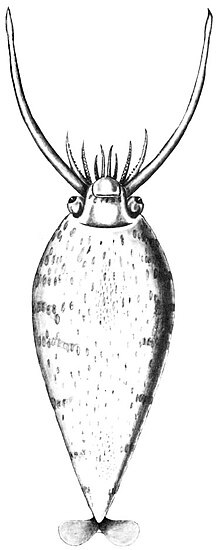Batoteuthis skolops, the bush-club squid, is the single rare species in genus Batoteuthis, which is the only genus in family Batoteuthidae. The squid is found in Antarctic waters, and reaches a mantle length of at least 350 mm (14 in). Some features of this creature are a small head, a long tail and a very peculiar tentacle, with six series of suckers on the club.

Chtenopteryx is a genus of small, muscular, midwater squid in the monotypic family Chtenopterygidae. Four species are presently recognized in the genus, but more are believed to exist.

Histioteuthidae is a family of Oegopsid squid. The family was previously considered to be monotypic but the World Register of Marine Species assigns two genera to this family.
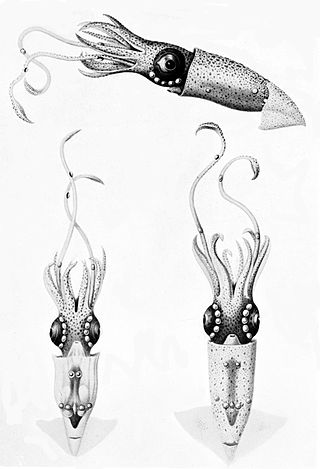
Lycoteuthis is a genus containing two species of squid: Lycoteuthis springeri and Lycoteuthis lorigera. They are small animals which grow up to 8 cm (3.1 in) in length.
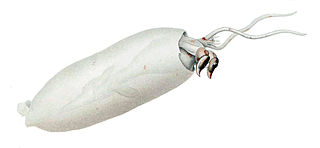
Taoniinae is a subfamily containing ten genera of glass squids.

Galiteuthis is a genus of glass squids from the family Cranchiidae and the subfamily Taoniinae. Squids in the genus Galiteuthis are large squids with mantle lengths measuring up to 660 mm (26 in), although it has been suggested that mantle length could reach as much as 2.7 m. The most distinctive feature of the speciesa in this genus are they have hooks on the tentacular clubs while there are no hooks on the arms, and by their long, thin, terminal fins.
Egea inermis is a species of glass squid in the monotypic genus Egea.
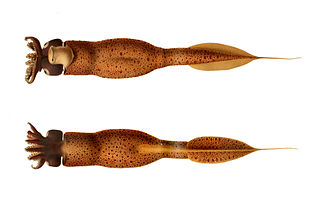
Taonius is a small genus of glass squid. Although it comprises only three recognised species, it has been suggested there may be as many as five species. Taonius borealis is found in the North Pacific Ocean and Taonius pavo is found in the Atlantic and possibly the south-western Indian Ocean.

Teuthowenia is a genus of glass squid in the subfamily Taoniinae. Members of this genus are characterized by their deep-sea habitat, clear bodies, and ability to engorge themselves with water to become larger when threatened. Each known species has a visible digestive gland, which serves a similar purpose as a stomach and liver.
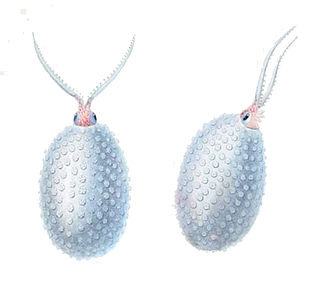
Cranchia scabra is a species of glass squid. It is the only species in the genus, and is fairly small. The mantle is covered by large, multi-pointed cartilagenous tubercles. When disturbed, the squid often pulls its head and arms into the mantle cavity and folds its fins tightly against the mantle to form a turgid ball. The tubercules, presumably, provide some type of protection, but it is unclear what predators are affected and how. In addition, the squid may ink into the mantle cavity, making the ball opaque. This was thought to be an aberrant behavior due to the stress and confinement of shipboard aquaria, until the same inking behavior was seen in cranchiids from submersibles. The function of this behavior is unknown.

Helicocranchia pfefferi, the banded piglet squid, is a small squid of the genus Helicocranchia. Adults of this species are mesopelaegic.
Echinoteuthis is a genus of whip-lash squid containing approximately three to five species. Some teuthologists consider Idioteuthis synonymous with this taxon.
Pickfordiateuthis is a genus of tiny squid in the family Loliginidae. While four species have been assigned to the genus, only three have been named. No member is known to reach a maximum mantle length of more than 22 mm.
Cycloteuthis is a genus of squid in the family Cycloteuthidae. It is distinguished from the genus Discoteuthis by the presence of a tail on the mantle. The species C. akimushkini is currently considered a junior synonym of C. sirventi, however this is inconclusive and the World Register of Marine Species has C. akimushkini as a valid species.
Discoteuthis is a genus of squid in the family Cycloteuthidae. It is distinguished from the genus Cycloteuthis by the absence of a tail on the mantle. The genus occurs in tropical and subtropical oceans worldwide.
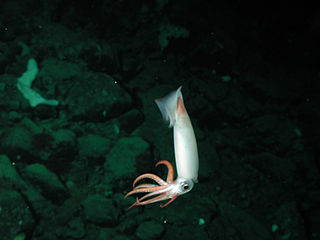
Gonatus is a genus of squid in the family Gonatidae, comprising twelve species, and therefore containing the most species in the family. Adult squid belonging to species in this genus are notable for their lack of tentacles.

The neon flying squid, sometimes called the red flying squid, akaika, and red squid is a species of large flying squid in the family Ommastrephidae. They are found in subtropical and temperate oceanic waters globally.
Lampadioteuthis megaleia is a small, colorful squid, the only species in the only genus in the monotypic family Lampadioteuthidae. It is sometimes known as the wonderful firefly squid. It was formerly classified in the family Lycoteuthidae, but differs from them mainly by having a hectocotylus in the males and by the possession of a rostrum on the gladius.
Eucleoteuthis is a monotypic genus of squid from the family Ommastrephidae; the only species is Eucleoteuthis luminosa, the striped flying squid or luminous flying squid.
Ornithoteuthis is a small genus of squid, with two species, from the family Ommastrephidae, the "flying squids", the two species in this genus are known as "bird squids". They are relatively small squid, with mantle lengths of around 100–200 mm (3.9–7.9 in), highly agile and rather uncommon. Their characteristics that distinguish then from other members of the subfamily Ommastrephinae are that their mantle and fins are drawn out into a narrow tail and that they have a luminous stripe along their midline on the viscera.
